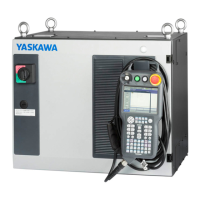4 Teaching
4.1 Teaching Operation
4-2
HW1485509
HW1485509
4.1.2 Jogging the Robot for Teaching
Before teaching and recording a Robot motion in the INFORM job, the
Robot needs to be moved to the position of interest. This motion is
manually performed by the operator using any of the methods described
in chapter 2.4 “Coordinate Frames and Manipulator Jogging”.
4.1.3 Motion Type (Interpolation Type)
Interpolation type determines the path along which the manipulator
moves between playback steps. Play speed is the rate at which the
manipulator moves.
Normally, the position data, interpolation type and play speed are
registered together for a Robot motion step.
4.1.3.1 Joint Interpolation
Joint interpolation is used when the manipulator does not need to move in
a specific path toward the next step position. When the joint interpolation
is used for teaching a Robot motion, the instruction is JointMove. Use
joint interpolation to teach the first step. This will avoid unintentional
motion errors in the singularity posture at the beginning of the motion.
Play Speeds are indicated as percentages of the maximum rate of joint
speed.
4.1.3.2 Linear Interpolation
When the manipulator TCP moves in a straight line path from one taught
step to the next, it is described as linear interpolation. When linear
interpolation is used to teach a Robot motion, the instruction to use is
LinearMove. The manipulator will move automatically while changing the
wrist position as shown in the figure below.
Play Speeds are indicated as mm/sec of the TCP speed. The maximum
TCP speed is manipulator dependent.
4.1.3.3 Circular Interpolation
When the manipulator TCP moves in an arc that passes through three
points, the movement is described as a circular interpolation. When
circular interpolation is used for teaching a Robot motion, the instruction to
use is CircleMove.
Play Speeds are indicated as mm/sec of the TCP speed. The maximum
TCP speed is manipulator dependent.

